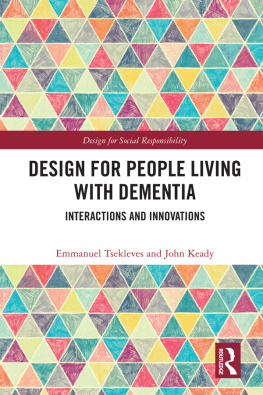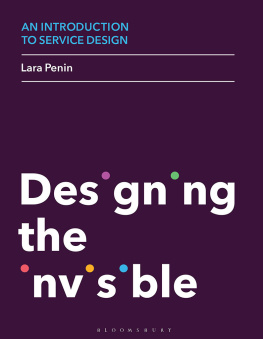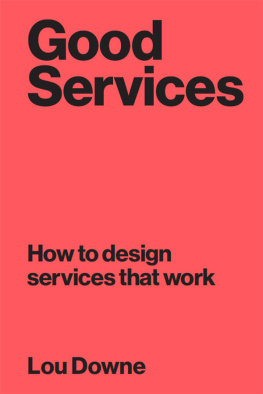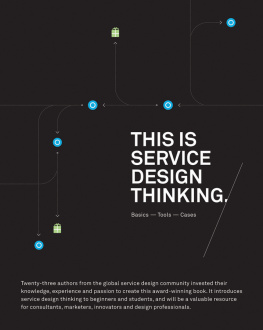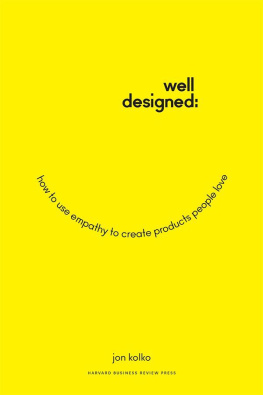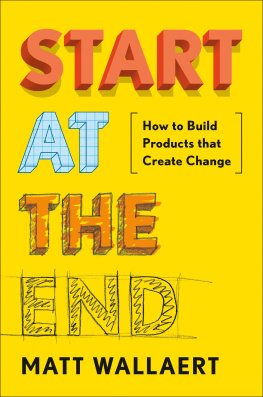ACKNOWLEDGMENTS
Thanks to our editor, JoAnn Simony, and to our publisher, Lou Rosenfeld, for their enormous patience, support, and guidance as we hashed out the structure of this book and knocked it into shape. Thanks also to the Rosenfeld production team for all their work getting the book into its print and digital forms.
Thank you to Dave Gray and Jess McMullin, who reviewed the early manuscript, and special thanks to John Thackara, who also reviewed the manuscript and wrote the inspiring Foreword.
Thanks to Chris Risdon, Lucy Kimbell, John Kolko, and Christina Tran for their contributions from their practice, and to all of the staff at live|work, both past and present, whose thoughts, practical tips, and work appear throughout the book. Much of the text on insights research tips and tricks comes from Rory Hamilton and Jaimes Nel sharing their experiences. In particular we wish to thank John Holager and Anders Kjeseth Valdersnes, who helped set up the live|work Oslo office, and Tennyson Pinheiro and Luis Alt, who brought live|work to Brazil. Our thanks also to Gjensidige for allowing us to publish the extensive case study of their business, and to Giles Andrews from Zopa and Joe Gebbia from Airbnb, who both gave their time to talk to us about their innovative business models.
Finally, thanks to all the many people upon whose shoulders we stand and upon whose work service design has been built.
***
Thanks to my family for their support, and to my colleagues, conference attendees, service design community, and Twitter followers for helping me refine my ideas. Thanks are due to my students, whose challenging questions and problems have helped clarify my own. I would also like to acknowledge the memory of Andy Cameron, who passed away in 2012 at far too young an age. He was a mentor for me, and his insight and intellect greatly shaped my own thoughts about people, culture, interactive media, and as a result, service design. Finally, thanks to Ben and Lavrans for being my co-authors. Any errors or omissions in the book are, of course, entirely their fault.
Andy Polaine
***
First of all, thanks to Chris Downs, the original founder of live|work, for his exceptional creativity, generous intelligence, and insulting sense of humor. The experience of starting live|work together was a gift beyond our dreams.
Thanks to Gillian Crampton Smith, who first introduced us to the history and future of interaction design at the Royal College of Art at the end of the last century, and then helped us develop service design through teaching at the Interaction Design Institute Ivrea at the beginning of the new century.
Thanks to mentor and friend Birgitta Cappelen for never-ending inspiration and support.
Bill Moggridge, who sadly passed away shortly before publication of this book, was a huge inspiration and support for our practice and our writing. We would have loved to show this book to him.
Thanks to Colin Burns for practical support in the early years of live|work.
Thanks to all our engaged and passionate clients and partners with whom we have broken new ground. You are too many to mention, but you know who you are.
Finally, thanks to Andy, who got the idea for this book off the ground, continually drove the writing process forward, and committed to the tremendous task of single-handedly making it all come together in the end. This is your book.
Lavrans Lvlie and Ben Reason
ABOUT THE AUTHORS
Andy Polaine has been involved in interaction design since the early 1990s and was co-founder of the award-winning new media group Antirom in London. He was a creative producer at Razorfish (UK), and later Interactive Director at Animal Logic in Sydney. Andy was Senior Lecturer and Head of the School of Media Arts at The University of New South Wales, and holds a PhD from the University of Technology, Sydney, in which he examined the relationship between play and interactivity. Now living in Germany, he divides his time between being a Research Lecturer in Service Design at the Lucerne School of Art and Design, Switzerland, and his work as an independent service and interaction design consultant and writer. His personal site is Playpen (www.polaine.com/playpen), and he can be found on Twitter as @apolaine.
***
Lavrans Lvlie has worked as a design consultant since 1994. Before setting up live|work in London with Chris Downs and Ben Reason, he worked as an interaction designer in Norway and Denmark. As a partner in live|work, Lavrans has been the lead designer on service innovation projects for Sony Ericsson, Sony, Samsung, Aviva/Norwich Union, the BBC, Oslo University Hospital, Johnson & Johnson, the United Kingdoms Design Council, Orange, and Vodafone. He has also served on the committee responsible for the British Standard for Service Design.
Lavrans has lectured and run seminars at the Interaction Design Institute Ivrea (Italy), Kln International School of Design (Germany), Oslo School of Architecture (Norway), Institute of Health and Society at the University of Oslo, University of Art and Design Helsinki (Finland), the Estonian Academy of Arts, and Cranfield School of Management (UK). He also serves as a board member at the Norwegian Design Council.
***
Ben Reason is a co-founder of live|work. He graduated from Liverpool John Moores University in 1994 with a BA in Fine Arts, followed in 2000 with an MSc in Responsibility and Business Practice from the University of Bath. Ben has a background in design and innovation in network-enabled services, and prior to live|work worked with Web agencies Razorfish and Oyster Partners.
Ben has provided strategic guidance and project delivery management on a range of high-profile projects for organizations such as the NHS, BBC, UK Home Office, Johnson & Johnson, and Transport for London. In 2009 he was voted one of the top 20 most influential designers in IKON magazine. Ben has taught service design at Goldsmiths London, Interaction Design Institute Ivrea, and the Royal College of Art.
CHAPTER 1
Insurance Is a Service, Not a Product
Insurance rarely comes to mind as an industry that provides a rewarding customer experience. The only time people find out whether their insurance company is actually any good is when they are at their most distressed and vulnerable. When they find out their insurance is awful, there is nothing they can do about it. They are at the mercy of small print they either did not read or did not understand, and they may end up spending hours on the telephone or filling out more paperwork. There should be insurance against mistreatment by insurance companies.
For many insurance companies and the people working for them, the lofty goal is to be the least awful with the minimum effort possible. The insurance market has ended up in a race to the bottom, competing only on price because customers do not understand their complex policies, hence the proliferation of insurance price-comparison websites.
Part of the problem is that insurance is complicated, involves multiple stakeholders and channels, and is a classic example of a service that is often sold as a product. The mix of complexity, human experience, multiple stakeholders, and delivery channels, combined with customer dissatisfaction with an industry stuck in its ways, makes insurance a perfect candidate for disruptive service design.
In 2009, Norways largest general insurer, Gjensidige (pronounced yen-SEE-dig-ah), decided they had had enough of competing in this toxic marketplace on the same level as their competitors. As a financial group with a 150-year history, Gjensidige had a solid position in the market, but they had a strong drive to improve the quality of service they were offering their customers. CEO Helge Leiro Baastad decided that customer orientation should be a main strategic focus and a key competitive advantage for the firm.




